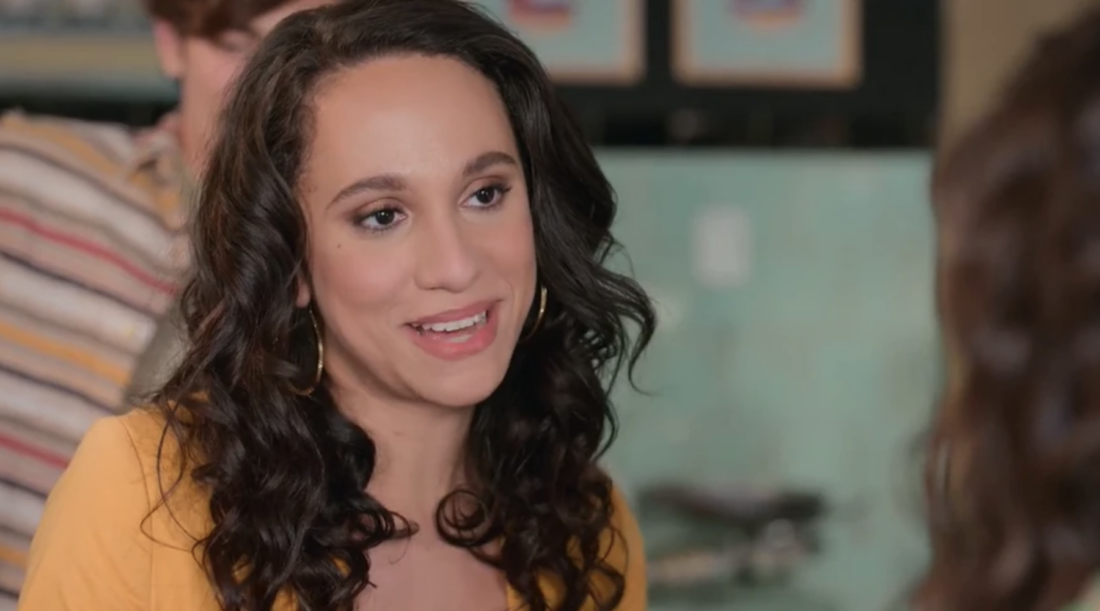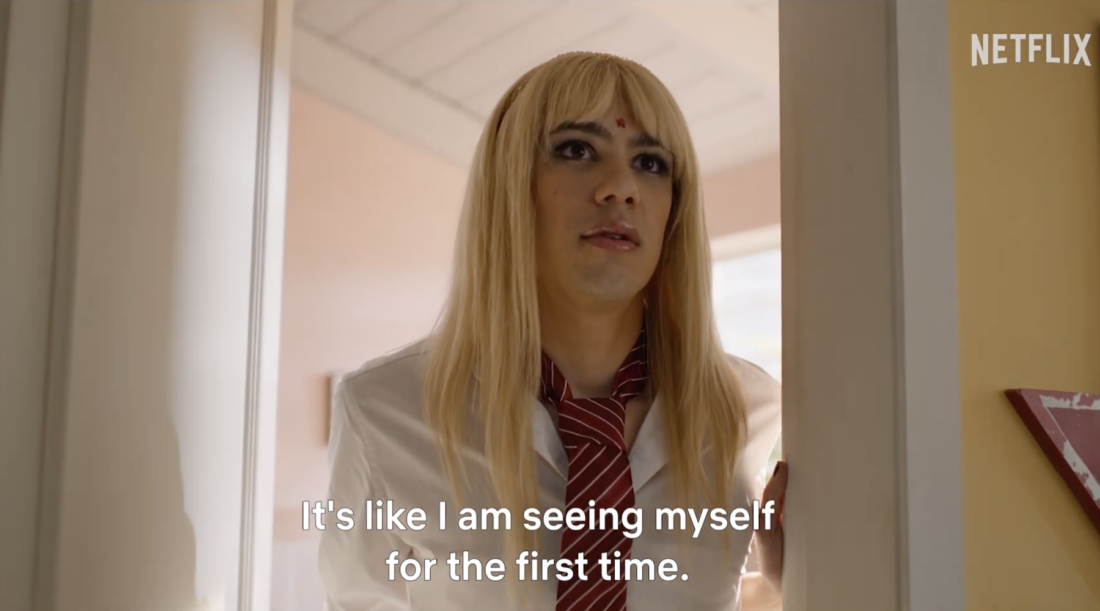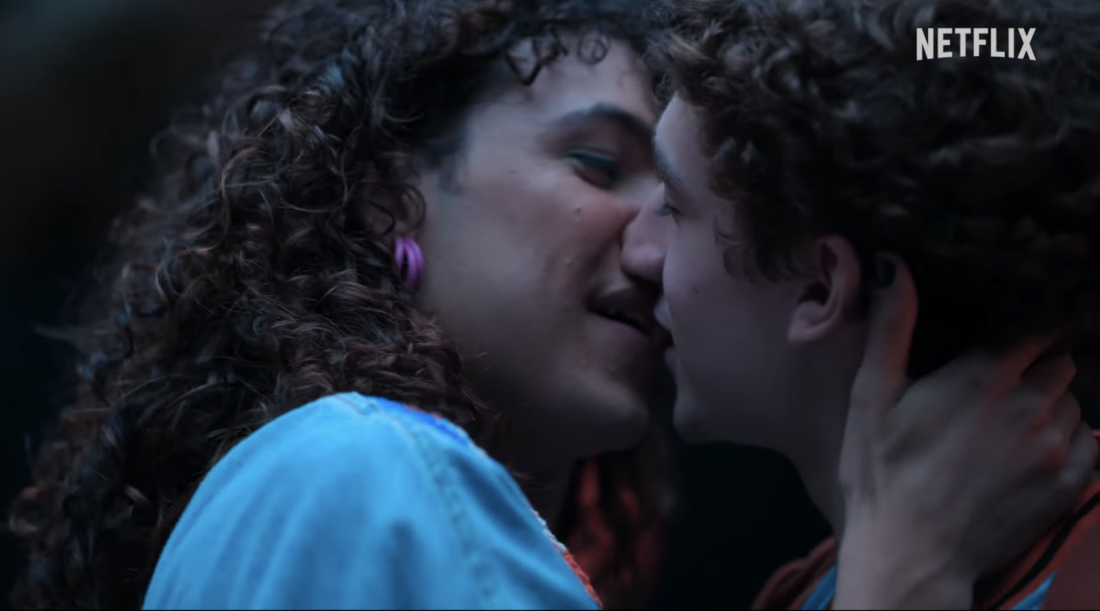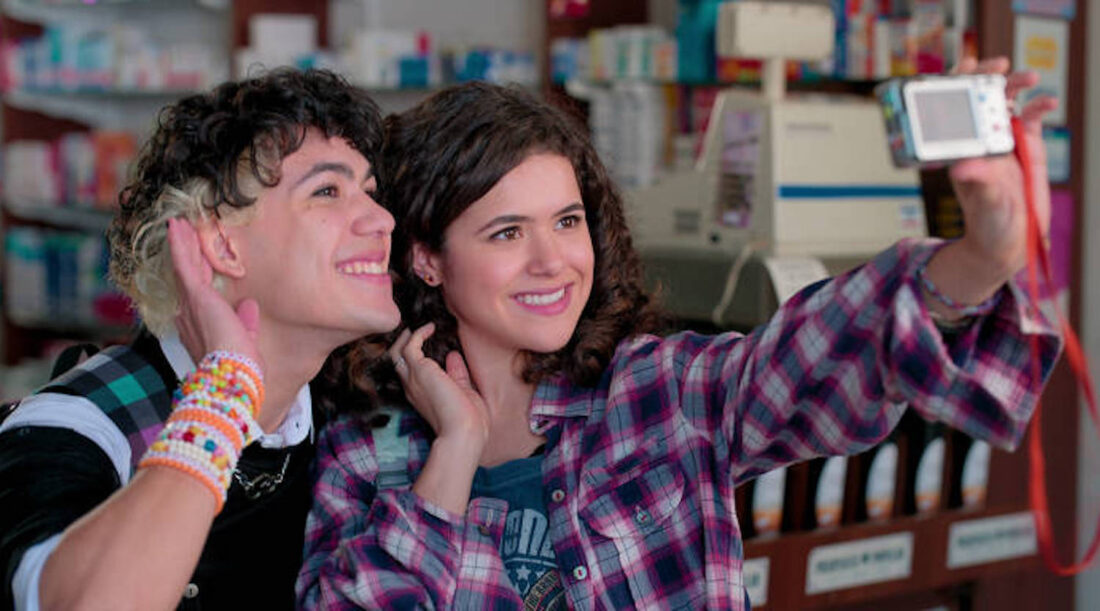One thing I appreciate about Netflix is the wealth of Brazilian TV shows and movies—this was super useful when I was learning Brazilian Portuguese. But also, some of my favorite genre shows lately are coming out of Brazil and kind of going under the radar in the United States. One of my favorite Brazilian SF/fantasy shows released its third and final season a couple weeks ago, and I was so happy to get one more chance to bask in its queer brilliance.
In Back to 15 (De Volta Aos 15), Anita is a thirty-year-old loser… until she decides to look at her old photoblog from when she was fifteen. (Basically, a photoblog is what people used before Instagram.) Suddenly, Anita is yanked back in time, and finds herself in her 15-year-old body on the first day of high school. She soon discovers that whenever she posts a new teenage photo to her photoblog, she returns to the present—but things have changed drastically, due to her meddling in the past. She starts going back and forth, making tweaks to the past and trying to fix all of her friends’ lives.
Yes, it’s very silly. But you know what? Time travel is a concept that lends itself to a lot of silliness. And in many ways, De Volta Aos 15 feels like a throwback to a kind of show that people in the United States don’t make as much anymore. Tonally, it reminds me of an old-school CW or Disney Channel show, or something like Kyle XY. It’s cute and off the chain, while finding ways to comment on issues like bullying, toxic masculinity, and gentrification.
And most of all, I love Anita’s best friend, a trans girl named Camila, whose transition is handled with a lot of sensitivity and realness. Nila, who plays the 15-year-old version of Camila, was actually going through her transition while making the show. And trans actor/writer Alice Marcone, who plays the adult Camila, actually wrote two episodes of the show’s first season.
In order to find out more about this show, I was stoked to interview both Camila actors, Nila and Alice Marcone, plus one of the show’s writers in seasons two and three, Gautier Lee.
Adapting the book series…
Back to 15 was originally based on a series of books by Brazilian author Bruna Viera. Marcone was one of the writers who were involved in developing the show from the beginning. Though Marcone is an actor as well as a writer, she says, “I primarily work as a screenwriter because it’s challenging to find acting roles that suit me.”
Camila, the show’s trans character, is a minor supporting character in the books, and is also cisgender. But early on in the adaptation process, Marcone and creator Janaína Tokitaka decided to expand Camila’s role and make her trans. Says Marcone, “Since Netflix wanted to bring contemporary topics into the adaptation, we felt it would be meaningful to reimagine Anita’s best friend as a trans person.”
And when casting for the show began, Marcone auditioned for the role of the grown-up Camila, and was “thrilled to get it.”
“Camila’s story is deeply personal to me, and much of it is drawn from my own experiences,” says Marcone. Camila is a writer, like Marcone, and also studies psychology in college.
Not just “the trans character”

When Nila was cast as the teenage version of Camila, she had a lot of conversations with Marcone, and was happy to hear that they had similar ideas for the character. Since then, Nila says she and Marcone have become inseparable and the two of them have plans to develop projects together.
Nila says she started playing Camila “at a time when I was also understanding myself as a trans person.” She changed her name to Nila and started “delving deeper into my transition” while they were filming the second season. Early on, she started having a lot of conversations with Marcone about shaping the character of Camila, and was happy to hear that the ideas she’d come up with were similar to what Marcone was already writing.
Marcone says that in the first season, she and the other writers wanted to use the pre-transition Camila to show “how the lack of LGBTQIA+ representation, both in media and society, can make self-discovery and self-recognition difficult for transgender people.” In the first season, Camila is still living as a boy, using an “emo” persona as the only way to express any femininity. In season two, the teenage Camila finally transitions. Says Marcone, “It was essential for us to craft a coming-out arc that was positive and drama-free, showcasing the acceptance from family and friends that many trans people need but rarely see portrayed.”
Nila says she was very concerned about “not turning Camila into ‘the trans character of the series.’” And this comes across. Camila isn’t just a trans kid slowly figuring herself out, she’s also an aspiring writer who pens stories about a heroic witch and obsesses about whether her stories will ever be good enough. (Luckily, in most of the future timelines Anita visits, Camila has become a bestselling fantasy author.)
“The thing I love most about building this character is the fact that Camila’s conflicts, though influenced by her appearances, are not solely restricted to her experience as a trans woman,” says Nila. Especially in the third season, Nila says, Camila gets to deal with situations that are more complex, including more writing struggles and romantic challenges. “I want people to see her as just another character who, like the others, is going through her own process of maturing.”
Adds Nila, “I think Back to 15 is a very pioneering series in this regard.”
“Honestly, I believe this character has huge generational appeal,” says Nila, who sees trans teenagers identifying with Camila and sympathizing with her struggles. Camila’s biggest challenges, says Nila, “lie in the realm of loneliness, insecurity and low self-esteem. Seeing Camila overcome these conflicts throughout the three seasons, reconciling with her family, finding love, and feeling sufficient within herself, is something inspiring for any child, teenager, or adult who feels like an outsider.”
Time travel as therapy

The notion of traveling back into the past appeals to our sense of nostalgia, says Marcone—until we discover that the past wasn’t as perfect as we thought it was. In De Volta Aos 15, Anita isn’t just using time travel to change her past and get rid of some of her problems as an adult—she’s also confronting the social issues that caused her life to go wrong. “Time travel stories help us reflect on who we are,” says Marcone, and maybe even gain acceptance of the choices that shaped us.
“Time travel can function like therapy,” adds Marcone. “In therapy, the idea is that by revisiting and retelling the past, you can reshape your present. This is the core premise behind many time travel stories, including Back to 15. Anita’s journey is about revisiting different moments and helping herself and others become better versions of themselves. The process of healing, growth, and self-improvement is similar to the therapeutic process of examining one’s past to create a better present and future.”
“De Volta Aos 15 is completely about self-discovery,” says writer Gautier Lee. “We wanted to show how even in the craziest of timelines, we can still become better people, find our people and grow together.”
Lee says Back to 15 was heavily influenced by time travel stories like Back to the Future (which is referenced a lot in season two), but also other time-travel narratives like Happy Death Day and Bryan Lee O’Malley’s comic book Seconds. When the show did an obligatory “Groundhog Day” episode and Lee was co-directing, she made sure to include the “fun montage” that every time-loop story needs. “I actually went back to some superhero shows that I used to watch in my late teen years such as The Flash and my favorite hero show so far: DC’s Legends of Tomorrow. Both of them had great ‘fun montages’ that helped me bring an extra dose of fun.”
This show keeps getting more gay

Camila appears to be the only queer character in the first season of De Volta Aos 15—but in season two, suddenly Anita’s sister is having an awesome lesbian romance and more queer characters are turning up.
Making the show more queer “came naturally to us,” says Lee, who joined the writing staff in season two. Bruna, a musician character, had a guitar she’d stolen from her ex, and the writers decided that the ex could be a girl, making Bruna a lesbian. Later, Anita’s sister Luiza was looking for someone to make out with, and the writers decided this should end up being Bruna. “We tried to build queer stories that felt as natural as any other teenage issue,” says Lee.
As for the show’s goofy tone, Marcone says this was driven by Netflix’s desire for a “feel-good” show—but even though Marcone usually writes darker material like horror or thrillers, she’s come to appreciate how humor can help audiences absorb the themes she wants to write about.
Lee, a Black non-binary dyke, says that having queer and BIPOC writers in the room “helped us see even clearer the beauty of being young, queer, and a bit confused by life as any teenager is.” The queer teenagers, most of all, needed to be teens first and foremost: screwing up, rebelling against their parents, falling in love and having their hearts broken. Lee says that when De Volta Aos 15 became Netflix’s top non-U.S. show for two weeks in a row, this proved that diversity behind the scenes leads to better outcomes.
This article was originally published at Happy Dancing, Charlie Jane Anders’ newsletter, available on Buttondown.

